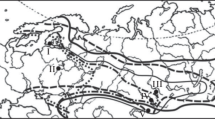Abstract
In the sparse larch forests of the upper Kolyma River, hypopi of the mite Anoetus myrmicarum (Scheucher, 1957) were found in several nests of the ant Formica lemani Bondroit, 1917. These mites were not found in hundreds of nests of the other 10 ant species examined in northeastern Asia. A possible ecological and physiological conditionality of the restricted distribution of phoretic mites was analyzed. For this purpose, coldhardiness of mites and their ant hosts, the biotopic distribution and the structure of nests, and the temperature conditions of overwintering were examined. At the stage of hypopus, the mites overwintered on ants in the overcooled stage; their mean supercooling temperatures (SCP) varied from −25.8 ± 0.3°C to −27.7 ± 0.4°C (min −32.2°C, n = 157). These values were by 0.1 to 7.0°C lower than the mean SCP of the ants from 8 tested nests of F. lemani (−20.7 ± 0.5°C to −25.7 ± 0.8°C). The soil temperatures at the level of winter chambers varied from −12°C to −15°C. Scarcity of findings of Anoetus myrmicarum in the Kolyma Highland is not associated with the limited cold-hardiness of the examined stages, but is most probably determined by interrelations between mites and ants.
Similar content being viewed by others
References
Antonov, I.A. and Pleshanov, A.S. “Landscapeecological Complexes of Ants of Baikal Siberia,” Sib. Ekol. Zh. 1, 53–57 (2008).
Berman, D.I. and Zhigulskaya, Z.A., “Cold-resistance of the Ants of the North-West and North-East of the Palaearctic Region,” Acta Zool. Fenn. 199, 73–80 (1995).
Berman, D.I., Alfimov, A.V., Zhigulskaya, Z.A., and Leirikh, A.N., Overwintering and Cold-hardiness of Ants in Northeastern Asia (KMK, Moscow, 2007) [in Russian].
Berman, D.I., Leirikh, A.N., and Zhigulskaya, Z.A., “A Common Strategy of Cold-hardiness in Ants of the Genus Myrmica (Formicidae, Hymenoptera) in North-East Asia,” Zool. Zh. 91(2), 175–189 (2012) [Entomol. Rev. 92 (3), 247–262 (2012)].
Dlussky, G.M., Ants of the Genus Formica (Hymenoptera, Formicidae, g. Formica) (Nauka, Moscow, 1967) [in Russian].
Dmitrienko, V.K. and Petrenko, D.S., Ants of Taiga Biocenoses of Siberia (Nauka, Novosibirsk, 1976) [in Russian].
Ermilov, S.G., “On the Study of Acariform Mites (Acariformes), Phoretic on Ants (Hymenoptera, Formicidae) under Urban Conditions,” in Ants and Forest Protection: Proceedings of the XIII All-Russia Mirmecological Symposium (Nizhny Novgorod, 2009), pp. 68–71.
Klimov, P.B., Candidate Dissertation in Biology (Vladivostok, 1999).
Eickwort, G.C., “Associations of Mites with Social Insects,” Ann. Rev. Entomol. 35, 469–488 (1990).
Kielczewski, B. and Wiśniewski, J., “Acarozy mrówek,” Prace komisji Nauk Rolniczych i komisji Nauk Leśnych 21(1), 118–120 (1966).
Lehtinen, P.T., “Association of Uropodid, Prodinychid, Polyaspidid, Antennophorid, Sejid, Microgynid, and Zerconid Mites with Ants,” Entomol. tidskr. 108, 13–20 (1987).
O’Connor, B.M., Candidate’s Dissertation in Biology (Cornell. Univ., Ithaca, New York, 1981).
O’Connor, B.M., “Evolutionary Ecology of Astigmatid Mites,” Ann. Rev. Entomol. 27, 385–409 (1982).
Scheucher, R., “Systematik und Ökologie der deutschen Anoetinen,” Beitr. Syst. Ökol. Mitteleurop. Acarina 1(1), 233–384 (1957).
Sevastyanov, V.D., “On the Number of Ticks Transported and Destroyed by the Carpenter Smeller Ant (Lasius fuliginosus Latr.) During the Season,” Zool. Zh. 44(2), 1651–1660 (1965).
Sevastyanov, V.D., “Some Regularities in the Distribution of Myrmecophilic Mites on Host Ants,” in Abstracts of Papers. The First Acarological Conference (Nauka, Moscow-Leningrad, 1966), p. 183.
Sevastyanov, V.D., “On the Significance of Red Wood Ants in the Distribution of Mites in Forests,” in Ants and Forest Protection: Proceedings of the 3rd All-Union Symposium on the Use of Ants in for Control of Forest Pests (Moscow, 1967), pp. 35–38.
Sevastyanov, V.D., “Mite Fauna of Red Wood Ants Formica rufa L.,” in Oribatids (Oribatei), Their Role in Soil-forming Processes (Pyargale, Vilnius, 1970), pp. 143–147 [in Russian].
Zhigulskaya, Z.A., “Ecology of Formica lemani (Hymenoptera, Formicidae) in the Upper Kolyma,” in Biological Problems of the North, Abstracts of Papers. All-Union Symposium (Yakutsk, 1986), pp. 134–135.
Author information
Authors and Affiliations
Corresponding author
Additional information
Original Russian Text © Z.A. Zhigulskaya, D.I. Berman, 2014, published in Zoologicheskii Zhurnal, 2014, Vol. 93, No. 5, pp. 636–640.
Rights and permissions
About this article
Cite this article
Zhigulskaya, Z.A., Berman, D.I. Cold-hardiness of the phoretic mites Anoetus myrmicarum (Acariformes, Anoetidae) from the ants Formica lemani (Hymenoptera, Formicidae) in the Kolyma Highland. Entmol. Rev. 94, 920–924 (2014). https://doi.org/10.1134/S0013873814050116
Received:
Published:
Issue Date:
DOI: https://doi.org/10.1134/S0013873814050116




